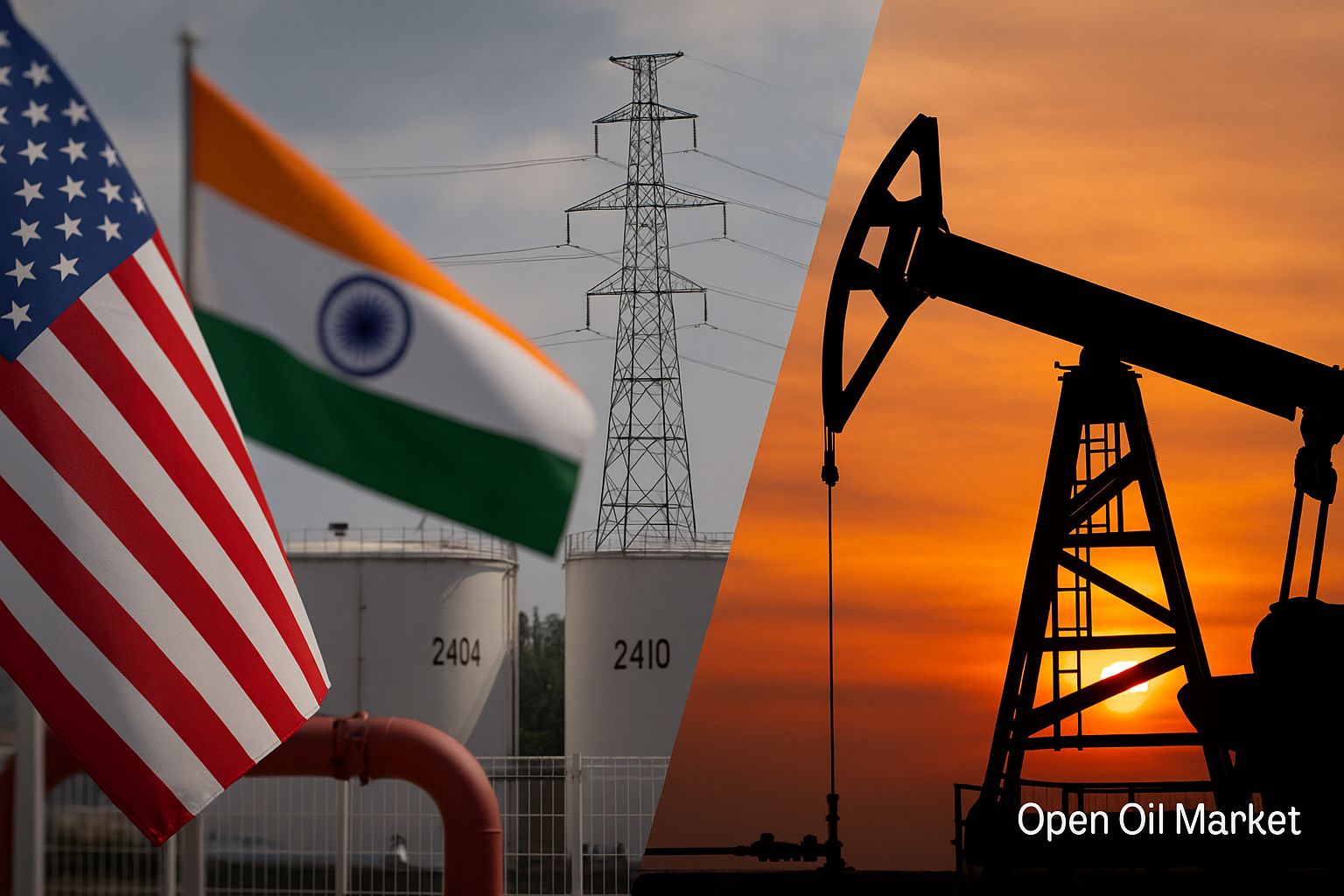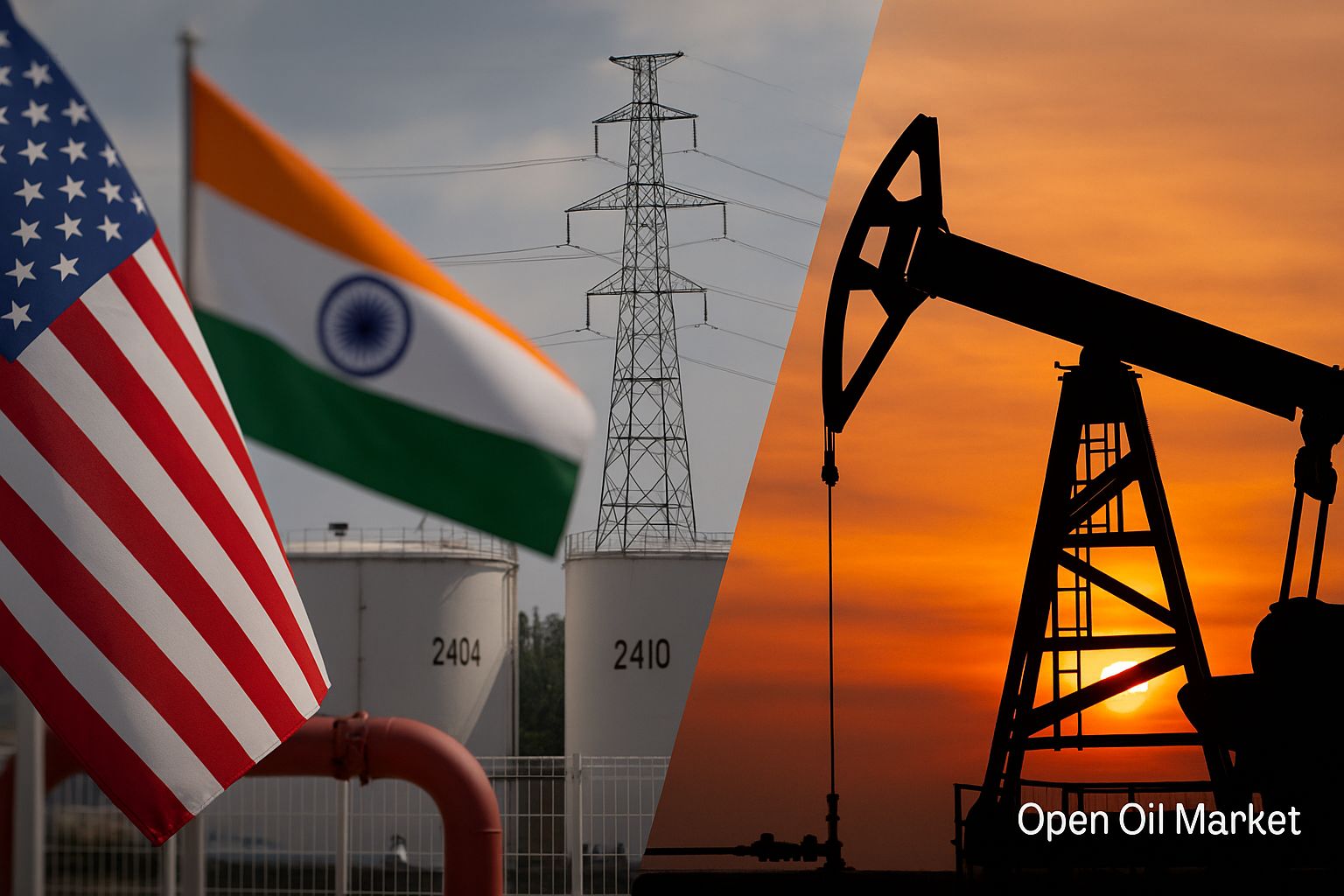
Global Energy Sector News as of August 8, 2025: The U.S. Intensifies Pressure on India over Russian Oil Purchases, Russia Limits Gasoline Exports, Oil Market Stabilizes, Europe Stockpiles Gas, Coal Makes a Comeback in Energy Production. Commentary from Open Oil Market.
Current events in the fuel and energy complex (TEC) as of August 8, 2025, are once again in the spotlight for investors and the market. Washington is ramping up sanctions pressure on major buyers of Russian oil—specifically targeting India with new tariffs that intensify geopolitical tensions. Against this backdrop, global oil prices have stopped declining and are demonstrating relative stabilization, as market participants assess OPEC+ actions and the risks of secondary sanctions. Russia maintains a strict ban on the export of petroleum products to support its domestic fuel market. Simultaneously, Europe is rapidly accumulating gas reserves ahead of winter, and the global energy sector is witnessing a resurgence in demand for traditional energy resources, such as coal, amid high prices and the need for reliable energy supply. Below are the details of the key news in the commodity and energy sectors.
Washington Doubles Tariffs for India over Russian Oil Trade
The United States has significantly intensified pressure on India, one of the largest global markets for Russian oil. On August 6, President Donald Trump signed an order to impose an additional 25% import tariff on goods from India, justifying it by New Delhi's continued purchases of Russian oil. The new tariffs are applied in addition to existing ones, doubling the total rate of U.S. tariffs on Indian exports from 25% to 50%. According to the document, the increase will take effect in 21 days. Trump had previously threatened “triple-digit” tariffs (100% or more) against countries purchasing energy resources from Russia if Moscow did not agree to cease hostilities in Ukraine by August 8—a date set by Washington as a deadline. While specific parameters for potential harsh sanctions have not been publicly clarified, the current step to double tariffs sends a clear signal to markets and trading partners.
The justification for the new measures notes that India is not only continuing to import large volumes of Russian oil but is also reselling some of these purchases on the open market for profit. The U.S. administration refers to such operations as undermining efforts to isolate Russia. Washington has also hinted that similar trade restrictions could threaten other countries actively purchasing hydrocarbons from the Russian Federation. Meanwhile, the U.S. signals its readiness to escalate sanction pressure after August 8 if its demands are not met. These steps exacerbate uncertainty in the global oil market, forcing energy companies to reconsider supply chains in light of potential new barriers.
New Delhi Rejects Claims and Points to Western Double Standards
India has responded decisively to the trade pressure from the U.S., calling its claims unfounded. The country's government asserts that it has no intention of halting imports of Russian oil, which are vital for the country's energy security. Traditional suppliers from the Middle East redirected their main oil volumes to the European market following the onset of the Ukrainian crisis, thus necessitating that New Delhi seek alternative sources. Furthermore, Indian officials emphasize that the Western states that now condemn India continue to cooperate with Russia in various domains. According to officials, the U.S. and the EU demonstrate "double standards": initially encouraging India to purchase Russian oil to stabilize the global market, only to criticize it for this practice now.
- National Interests Come First: India's key priority is ensuring affordable energy costs for the population and its economy. Purchasing Russian oil helps to curb rising fuel prices in the domestic market.
- The West Itself Traded with Russia: New Delhi reminds that EU countries still import gas, petrochemical products, fertilizers, and other resources from Russia, while the U.S. purchases specific categories of Russian goods (e.g., nuclear materials). This undermines the demand to fully refrain from trade with Russia.
- Unfair Criticism: Indian officials note that Washington's accusations are unfounded, considering that Western partners previously urged India to buy oil from Russia to stabilize prices. Now, however, New Delhi faces unjust accusations for continuing to act in its own interests.
Indian leadership underscores that it will protect its national interests and economic security. Should the trade conflict with the U.S. escalate, India may resort to countermeasures and more actively pivot toward alternative partners—such as China or Middle Eastern countries willing to collaborate outside the sphere of U.S. sanctions.
Oil Market: Prices Recover from Decline amid Sanction Risks
After several days of decline, global oil prices have stopped falling and partly rebounded. On August 6, benchmark Brent crude prices rose back to around $68–69 per barrel, while U.S. West Texas Intermediate (WTI) traded around $66. The increase of approximately 1% over the day was influenced by several factors. First, statistics from the U.S. Department of Energy indicated an unexpected decrease in commercial oil stocks by about 3 million barrels over the last week, signaling robust demand and supporting the market. Second, investors are factoring in the potential for supply disruptions due to escalating sanctions: paradoxically, news of the tariffs imposed by Trump against India pushed oil prices higher, as the market anticipates a redistribution of oil flows and additional supply risks.
Nevertheless, the price increase remains limited. One reason is OPEC+'s proactive stance, which has already been priced into the market. The alliance of oil-producing countries previously agreed to increase production starting in September, and expectations of increased volumes are moderating the situation. Additionally, concerns over slowing global economic growth and weak demand in China are preventing prices from spiking sharply. Several analytical agencies have revised their forecasts, anticipating an average Brent price in the fourth quarter of 2025 at around $60–65 per barrel. However, most experts believe a deep price collapse is unlikely; as prices approach critically low levels, OPEC+ countries may cut supply again to support the market.
OPEC+ Increases Oil Production, Proceeding Cautiously
OPEC+ countries continue a policy of gradual oil production increases. At the beginning of August, several key participants in the agreement (including Saudi Arabia, Russia, the UAE, Kuwait, and others) announced an increase in the combined production quota by 547,000 barrels per day starting in September. This signifies the premature end of voluntary cuts implemented at the end of 2023 (when the group of countries voluntarily limited production by a total of 2.2 million b/d). Now, thanks to monthly increases in production from April to August and the announced measure for September, these restrictions will be fully lifted more than a year ahead of the original plan.
The market reacted calmly to the news of increased supply. The OPEC+ decision was expected and already factored into prices, so it did not cause significant upheaval. Furthermore, the increase in quotas occurs amid ongoing geopolitical tensions, which softens the effect on prices. Experts note that it is important for OPEC+ countries to regain market shares lost during the restriction period without triggering a price collapse. Allies are closely monitoring the situation: further steps will be discussed at the OPEC+ monitoring committee meeting on September 7, where the fate of remaining voluntary limits of 1.65 million b/d (extended to the end of 2026) will be evaluated. For now, the alliance demonstrates unity and aims for a gradual increase in supply in response to recovering demand.
The Russian Oil Products Market: Export Ban, Prices, and Budget Under Control
In the domestic fuel market of Russia, a complete ban on the export of certain petroleum products, primarily automobile gasoline, continues to be in effect. The government has previously expanded restrictions to all producers and traders: from late July to August 31, 2025, gasoline exports from the country are prohibited. This emergency measure is aimed at saturating the domestic market and curbing the rise in gas station prices. According to the Moscow Fuel Association, the average retail prices for AI-92 gasoline in Moscow reached around 59 rubles per liter by early August, while AI-95 stood at approximately 65 rubles per liter, significantly higher than the levels at the beginning of the year. Despite the export ban, fuel prices at gas stations are gradually increasing, albeit at a slower pace compared to peaks in June.
To stabilize the situation, the government is utilizing budgetary mechanisms. In particular, oil refineries (refineries) are receiving compensation through a dampening mechanism—subsidies that mitigate the difference between high world prices and fixed domestic fuel prices. In July, the dampener payout amounted to approximately 60 billion rubles, helping to contain the rising cost of gasoline for end consumers. However, such expenses burden the federal budget, especially since oil and gas revenues were around 787 billion rubles in July, according to the Ministry of Finance—lower than planned and below expectations for the third consecutive month. The government is discussing the possibility of temporarily adjusting or suspending the dampener mechanism if oil prices and currency factors continue to reduce export earnings.
Commentary: “In July 2025, dampener payouts decreased by 58% compared to the same period in 2024 (to 59.9 billion rubles),” notes Sergey Tereshkin, CEO of the fuel marketplace Open Oil Market. “Oil companies are left with no choice but to raise prices in those market segments where fuel price increases are not associated with the risk of subsidy non-payment. These include exchange prices for AI-95 gasoline, which are not accounted for in dampener calculations, as well as prices in the over-the-counter wholesale segment.”
Source: Russian Gazette
Thus, balancing interests—maintaining fuel prices for the population while ensuring budget revenues—remains a challenging task for authorities and market participants.
Gas Sector: Europe Stockpiles Supplies and Restructures Routes
The European gas market is approaching the end of summer with robust stockpiling figures. Underground gas storage (UGS) in the EU is over 72% full as of early August, significantly higher than average values in previous years at this date. EU countries are actively injecting gas, striving to reach a target filling level of around 90% by November 1. High reserve levels and a steady influx of liquefied natural gas (LNG) from the U.S., Qatar, and several other exporters provide relative price stability in Europe: current exchange prices remain significantly below the peaks of 2022–2023.
The energy geography of gas supplies to Europe has significantly changed over the past year. Below are the key changes in routes and sources:
- End of Transit through Ukraine: as of January 2025, Russian pipeline gas supplies through the Ukrainian gas transportation system have completely ceased after the expiration of the contract between Gazprom and Naftogaz.
- Southern Corridor Becomes Main Route: the only remaining operational route for Russian gas to the EU is the “Turkish Stream,” along with its continuation through Turkey and the Balkans. About 50 million cubic meters per day are transmitted through this route, partially compensating for the volumes lost from the northern routes.
- Shutdown of Northern Streams: the “Nord Stream” pipeline has been rendered inoperative following diversions in 2022, while the “Yamal-Europe” pipeline is unused due to sanction disputes between Russia and the West.
- Record LNG Imports: the share of liquefied natural gas in the EU's imports has increased to an all-time high. European LNG reception terminals are working at high capacity, replacing the lost volumes of pipeline gas.
- Local Solutions: within Russia, Gazprom is optimizing internal logistics: for example, after brief pauses, gas supplies to the Kaliningrad region via Lithuania have resumed, and a floating LNG terminal has been employed in case of disruptions. Though these technical maneuvers do not directly affect Europe, they highlight adaptation to new restrictions.
Thanks to the diversification of sources and stockpiling, Europe is entering the autumn-winter period more prepared than a year ago. Nevertheless, potential risks remain—from weather factors (a cold winter can sharply increase consumption) to competition with Asia for LNG cargoes. EU regulators and energy companies remain vigilant, continuously building reserves and developing infrastructure for gas reception and distribution. Overall, the current situation in the European gas market inspires cautious optimism: the threat of fuel shortages has been pushed back, although it is still too early to relax completely.
Coal Energy: Price Increases and the Return of Traditional Fuel
The global energy sector is displaying a remarkable trend: after several years of decline, the demand for coal is on the rise once again. Prices for thermal coal in the Asian market have been climbing for three consecutive months. In July, the average price of Australian coal reached approximately $113 per ton—the highest since the beginning of the year—while South African coal was trading around $94 per ton. The price increase is fueled by robust demand from power plants in Asian countries (China, India, Vietnam, etc.), where economic growth necessitates reliable energy sources. Despite global decarbonization goals, many nations find themselves compelled to increase coal combustion in the short term to ensure stable electricity supply.
The United States is witnessing a genuine "coal renaissance." In the first five months of 2025, electricity generation at coal-fired power plants in the U.S. increased by approximately 19% compared to the same period in 2024. According to the Energy Information Administration (EIA), around 25% of all electricity in the country is now produced from coal—a record share in recent years. This surge is attributed to several factors:
- High Gas Prices: Rising natural gas prices have made coal a more economically attractive option for generation, particularly in base-load capacities.
- Reliability of Energy Systems: To avoid disruptions, authorities and companies are keeping coal plants on standby to compensate for the inadequate stability of renewable energy sources.
- Political Support: The Trump administration rolled back a number of environmental restrictions and promotes fossil fuel production, including coal, as part of a push for energy independence. These measures have provided additional momentum for the coal industry.
Experts emphasize that while the development of renewable energy (wind, solar, etc.) continues to accelerate, an immediate transition away from traditional fuel sources is not feasible. The International Energy Agency predicts that global coal-fired electricity generation will start to gradually decline after 2025. However, the current situation demonstrates how challenging it is for energy systems worldwide to navigate the transition period without leveraging "old" resources. For investors, this is a signal that the oil, gas, and coal segments will continue to hold significance in the coming years—provided that modernization and environmental sustainability standards are prioritized.
For TEC Investors
Collectively, the news from Thursday reflects a complex and multifaceted picture of the global TEC. Geopolitical actions—such as U.S. sanctions pressure on buyers of Russian energy resources—introduce new risks and compel a restructuring of trade flows. Simultaneously, market mechanisms continue to function: OPEC+ balances supply increases with demand considerations, while consumers and businesses adapt to changing conditions, whether through seeking alternative suppliers or substituting energy sources. In traditional sectors (oil, gas, coal), there is a temporary strengthening of positions due to high prices and the urgency for stable energy supply, even in light of the strategic shift towards a "green" transition. Investors and companies within the fuel and energy complex in Russia and globally remain vigilant in monitoring these trends to make timely strategic decisions. The combination of flexibility and foresight in such an environment is becoming the key to success for market participants—from oil and gas corporations and refineries to power generation and the renewable energy sector.




